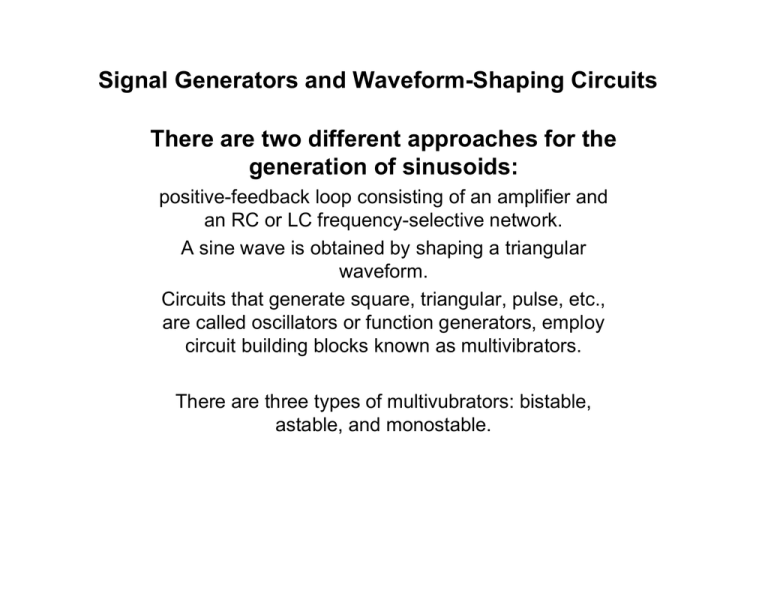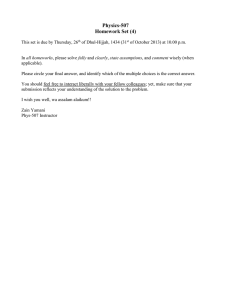Signal Generators and Waveform-Shaping Circuits There are two
advertisement

Signal Generators and Waveform-Shaping Circuits There are two different approaches for the generation of sinusoids: positive-feedback loop consisting of an amplifier and an RC or LC frequency-selective network. A sine wave is obtained by shaping a triangular waveform. Circuits that generate square, triangular, pulse, etc., are called oscillators or function generators, employ circuit building blocks known as multivibrators. There are three types of multivubrators: bistable, astable, and monostable. Sinusoidal Oscillators: Feedback Loop A( s ) Gain with Feedback : A f = 1 − A( s ) β ( s ) Loop Gain : L( s ) = A( s ) β ( s ) Characteristic Equation :1 − L( s ) = 0 Dependence of the Oscillator Frequency Stability on the Slop of the Phase Response L( jωo ) = A( jωo ) β ( jωo ) = 1 x f = βxo ; Ax f = xo Aβ = 1 vo = −( R f / R1 )v1 R3 R2 + vo R2 + R3 R2 + R3 R5 R4 v B = −V + vo R4 + R5 R 4 + R5 vA = V R R3 − VD 1 + 3 R2 R2 R R L + = V 4 − V D 1 + 4 R5 R5 L− = _ V vo = −( R f / R1 )v1 R3 R2 + vo vA = V R2 + R3 R2 + R3 R5 R4 v B = −V + vo R4 + R5 R4 + R5 R3 R3 L− = _ V − VD 1 + R2 R2 R4 R4 L+ = V − V D 1 + R5 R5 The slope of the transfer characteristic in the positive limiting region is − R f // R4 / R1 ( ) Exercise 13.2: Use a popular limiter circuit with V = 15 V, R1 = 30 kΩ, Rf = 60 kΩ, R2 = R5 = 9 kΩ and R3 = R4 = 3 kΩ. Find the limiting levels and the value of vI at which the limiting levels are reached. Also, determine the limiter gain and the slope of the transfer characteristic in the positive and negative limiting regions. Assume that VD=0.7 V. R4 + VD (1 + L+ = V R5 R4 3 3 ) = 15( ) + 0.7(1 + ) = 5.93 V 9 9 R5 R3 − VD (1 + L − = −V R2 Rf R3 3 3 ) = −15( ) − 0.7(1 + ) = −5.93 9 9 R2 60 Limiter gain = =− = −2 V/V 30 R1 5.93 Limiting occurs at ± = ±2.97 2 R f // R4 Slop in the limiting region = − = −.095% V/V R1 The Wien-Bridge Oscillator L( s ) = 1 + R2 Z p 1 + R2 / R1 = R1 Z p + Z s 3 + sCR + 1 / sCR 1 + R2 / R1 L ( jω ) = 3 + j (ωCR − 1 / ωCR ) 1 1 R2 =2 ωo CR = ; ωo = ; CR R1 ωo CR Design a Wien-bridge circuit to oscillate at fo = 20 kHz 1 1 = = 7.96 × 10 − 6 RC = 2πf o 2π (20 × 103 ) R = 10 Ω and C = 796 pF Since the amplifier resistor ratio must be R2 / R1 = 2 We may choose R2 = 20 kΩ and R1 = 10 kΩ A Wien Bridge Oscillator with a Limiter for Amplitude Control A Wien Bridge Oscillator with another Method for Amplitude Stabilization A Phase Shift Oscillator A Phase Shift Oscillator with a Limiter for Amplitude Stabilization A Quadrature-Oscillator Circuit Active Filter Tuned Oscillator Active Filter Tuned Oscillator




